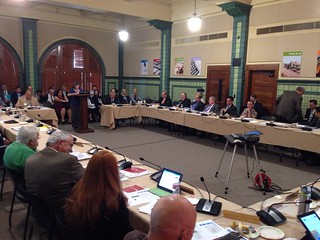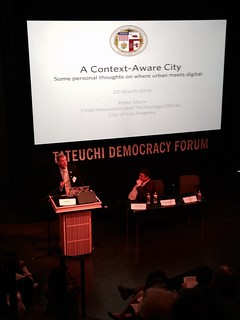 In early November 2013, the San Bernardino Association of Governments (SANBAG) board adopted a historic Memorandum of Understanding (MOU) (Item 7) with the Southern California Association of Governments (SCAG). The MOU commits the two agencies to working together on projects related to the implementation of the 2012 Regional Transportation Plan and Sustainable Communities Strategy (RTP/SCS). While the RTP/SCS is mandated by SB 375, state legislation to reduce greenhouse gas emissions through trying land use and transportation planning in the RTP process, the MOU is strictly voluntary.
In early November 2013, the San Bernardino Association of Governments (SANBAG) board adopted a historic Memorandum of Understanding (MOU) (Item 7) with the Southern California Association of Governments (SCAG). The MOU commits the two agencies to working together on projects related to the implementation of the 2012 Regional Transportation Plan and Sustainable Communities Strategy (RTP/SCS). While the RTP/SCS is mandated by SB 375, state legislation to reduce greenhouse gas emissions through trying land use and transportation planning in the RTP process, the MOU is strictly voluntary.
The MOU between SCAG and SANBAG demonstrates both agencies’ commitment to the policies, projects and strategies set forth in the 2012 RTP/SCS. It is important for County Transportation Commissions (CTCs) to show commitment to implementation of plans and policies.
Specific planning projects are included in SANBAG’s MOU that will transform San Bernardino County into a more walkable and bikeable place, improve the public health outcomes of its residents and help increase the number of children walking and bicycling to school. The MOU incorporates items recommended in the San Bernardino Active Transportation Vision, statistics and policy recommendations developed by stakeholders from San Bernardino County, including SANBAG staff, San Bernardino County Department of Public Health, Omnitrans, Safe Routes Partnership, American Lung Association, MoveIE and Inland Empire Bicycle Alliance.
 In May, a series of incomprehensible tragedies happened in the City of Portland and the surrounding region – vehicles hitting, hurting, maiming and killing people walking and riding bicycles. One crash after another.
In May, a series of incomprehensible tragedies happened in the City of Portland and the surrounding region – vehicles hitting, hurting, maiming and killing people walking and riding bicycles. One crash after another.





 The technologies drawing attention are user-centric that allow both users and providers to interact and share information about the transportation network. Active transportation and Safe Routes to Schools advocates should care about these trends because they are expanding transportation options, promoting active lifestyles and tipping the political scales towards multi-modalism in planning and implementation.The digital space is using the influx of information (i.e.
The technologies drawing attention are user-centric that allow both users and providers to interact and share information about the transportation network. Active transportation and Safe Routes to Schools advocates should care about these trends because they are expanding transportation options, promoting active lifestyles and tipping the political scales towards multi-modalism in planning and implementation.The digital space is using the influx of information (i.e.  In early November 2013, the San Bernardino Association of Governments (
In early November 2013, the San Bernardino Association of Governments (